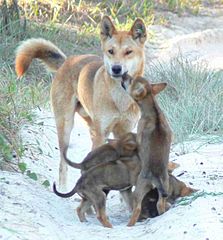
In 1980 a baby named Azaria disappeared from a campsite near Uluru (Ayers Rock). The Chamberlain family claimed a Dingo had taken the child. The child was never found, although her undamaged clothing was recovered from the bush not too far away from a Dingo den.
The authorities did not believe the Chamberlains. The state of Azarias clothing was a key point of contention. At that point in time, Austrialia also had no documented attacks of Dingoes on humans. Over time, the documentation of several contemporary attacks underscored the familys account. After multiple investigations and trials (including a wrongful murder conviction), the Chamberlains were taken seriously.
This June a coroner reissued Azarias official death certificate, and listed dingoes as the cause of death. The evidence is circumstantial, and perhaps the coroners report overstates the matter. But it does seem a reasonable supposition all things considered.
This was a horrible tragedy for the Chamberlains, as well as a miscarriage of justice. I hope this outcome brings them some relief.
Yet as I monitored and read up on this story, I felt a growing sense of unease and recognition. Unease because alongside themes of justice and closure for the family of Azaria, there were subtexts that demonized dingoes as dangerous predators in need of lethal controls. Recognition because North Americans have done much the same to its predators, particularly wolves and coyotes.
Dingoes (Canis lupus dingo) are the wolves and coyotes of Australia. They average about the size and weight of a medium to large size dog, and have an ecological role as apex predators. Dingos were first thought to have been brought to Australia as semi-wild dogs by Aborigines approximately 50 thousand years ago. Recent evidence indicates a more recent migration via the Indian subcontinent and/or East Asia. The current theory is that Dingoes were brought to Australia well after the Aborigines arrived, approximately 4 to 12 thousand years ago.
However they arrived, Dingoes quickly adapted to the ecologies of Australia, and reverted to wild dogs, albeit with a profound ability to live alongside and cooperate with Aboriginal humans. This may be an artifact of their former domestication, or an adaptive feature of pre-domesticated Dingoes. Ongoing human depredation and hybridization with domestic dogs are the current threats to the species. Dingoes have been extirpated in some areas and are endangered in others. Because of its isolation from the mainland, Fraser Island Great Sandy National Park is the last refuge for pure wild dingoes.
It has taken a long time for North Americans to acknowledge the ecological and moral value of wild predators like wolves and coyotes. Resistance to this knowledge is still substantial, and changing anti-predator policies is an ongoing challenge. This experience may have lessons for humans and Dingoes in Australia. Dingoes are not family pets, and should be respected at a distance because of that. Yet neither are they a pack of stray dogs. They have co-evolved with the flora and fauna of Australia to be the continents true wild dog. Their right to live wild and share the landscape of Australia should be respected as well. Australians, like North Americans, have a direct moral responsibility to co-exist with their canid predators.
I do hope the Chamberlains personal tragedy is set within the proper context, and the importance of respecting Dingo wildness and learning to live with them in shared landscapes is the final outcome of this long and difficult case.